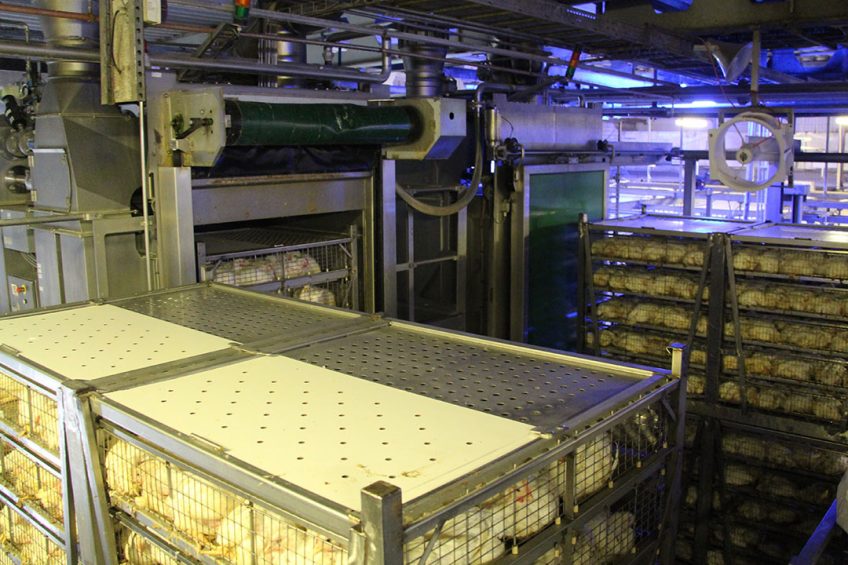Animal friendly and sustainable

The Dutch poultry processing plant 2 Sisters Storteboom has over 10 years’ experience with a very reliable and modern live bird handling system; the Meyn EVO system with automatic trailer unloading.
Meyn Food Processing Technology has one of the most modern, innovative and animal-friendly live bird handling systems in the world. It concerns the full automatic Meyn EVO system including the multistage CO2 stunning method of Meyn. According to Wouter Veerkamp, product manager at Meyn, up to today only a limited number of slaughterhouses in the world use the new automatic Meyn trailer (un)loading system. The system is now used in slaughterhouses in Germany, UK, USA, the Netherlands, and Poland. In 1993, 2 Sisters Storteboom B.V. was the first slaughterhouse in the world which integrated the first generation, the Laco system from Meyn. Veerkamp: “Since then Meyn has improved all aspects of the system, and related to the animal welfare and the product quality. Meyn added functionalities like CO2 stunning and improved the stainless steel modules.” Since 2012 this new Live Bird Handling method has been combined with the state of the art multistage CO2 stunning method of Meyn. Recently the latest improvements to the containers were integrated.
Continuous improvements
The EVO system takes animal welfare into account, it is a unique feature of the system. From the moment birds are placed into the containers at the farmhouse and loaded on the trailer, the birds remain in the container from farm to processing line – without rough handling from the unloading of forklifts until the stunning. When they are loaded into the stunner cabinet in the containers, the birds are not stressed and comfortable in their own environment. As this operation takes place in a calm manner. With selected lighting used to keep the birds calm as well. This largely reduces handling stress and thus the risk of injuries to the birds means that this optimises both animal welfare and profit.
The EVO Modules are built from stainless steel, improving sustainability, hygiene and reducing maintenance cost.The V-shaped opening of the Meyn EVO modules has been renewed since last year so that there is sufficient space to place the birds easily and carefully into the compartments. Birds are loaded bottom up inside the module, through a large opening that ensures birds are placed in the compartments without damage – manually or automatically. Veerkamp adds, “Even if the bird spreads its wings while loading, the entrance is sufficient to enter freely.” Other important parts of the drawers in the EVO containers are the non-slipping floors that ensure animal comfort during transport. The EVO modules can load up to 820 kg of live birds based on 160cm2/kg live weight (EU 2005/1). A trailer can load 20 or 22 modules, which means a total of over 18 tons of animals. During transport, heat stress is the biggest threat to animal welfare, and product quality, so sufficient ventilation is vital. For ventilation, free space above the heads of the animals is required. With 25 cm height and mesh sides, good ventilation is secured during transport and holding. Heat-stressed birds lose up to 0.2% weight per hour, so the design of the modules enhances both animal welfare and yield.

Smooth and gentle
In addition, the mesh of the compartments can easily be removed. Veerkamp states: “This allows quick and easy maintenance in case of any damaged mesh. Furthermore, this construction allows easy access to the animals in case of any necessity to check the birds’ health. As soon as the truck arrives at the plant, the driver opens the curtains depending on the weather. An important advantage of the automatic trailer (un)loading system is that the modules are offloaded on the skate conveyor within 10 minutes. The trailer can leave, for the next farm, within another 15 minutes after cleaning and loading the modules.” Unlike with other live bird handling systems, the birds don’t have to wait in the arrival area before being stunned.”
Once the truck is docked at the skate conveyor, all 22 modules are lifted on the trailer and moved on the skate conveyor. So, the birds don’t experience any shaking movements and will go smoothly and gently from the truck onto the skate conveyor.
The skate conveyor ensures that the modules move in a controlled way through the ventilated lairage until the stunning units. When the modules go into the stunning cabinet, the broilers stay in exactly the same position. The modules are transported with a special cross-conveyor from the buffer conveyor into the CO2 stunning cabinet, in a smooth and gentle way. All broilers get the right stun time. The construction of the containers guarantees that the CO2 can reach the broilers, which guarantees a proper stun. Upon completion of the stun cycle, the containers are automatically transported, destacked and unloaded.
Better meat quality
According to Martine Onderdijk, director corporate affairs at 2 Sisters Food Group, the EVO system has a significant influence on quality and yield. “Careful live bird handling optimises both animal welfare and profit. After 10 years of working with this system, we have experienced that the containers are less damaged in comparison to other systems. Also the yield is better because of the reduced damage.” According to Veerkamp the better yield is also due to the better airflow through these containers. “You really get a flow through the containers during transport. The maximised ventilation of the EVO system ensures a better meat quality. This applies to both standard and to slow growing broilers. If ventilation on a truck has been bad during transport, you will see it in the meat quality.”
With regard to near future developments in the field of live bird handling, Veerkamp does not expect that the transport of broiler chickens will be fully conditioned. “I do believe that monitoring the climate during broiler transport will become more daily routine in the future.”













